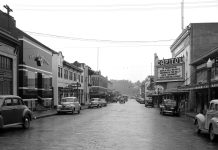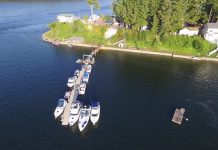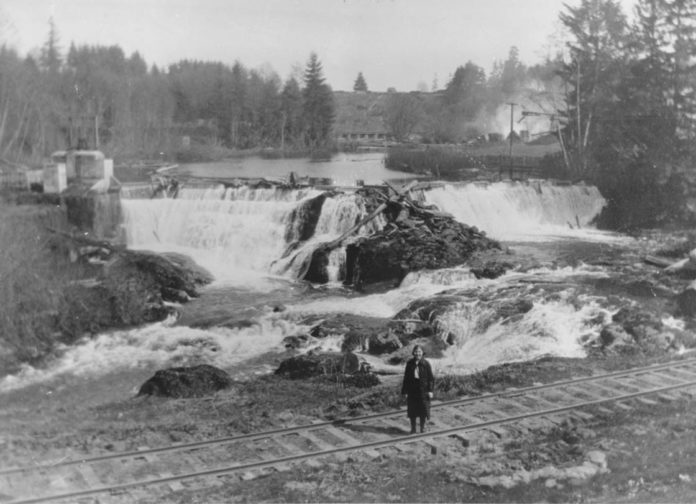
For more than 35 years, Tumwater Falls Park and Tumwater Historical Park have stood side-by-side but have remained unconnected to each other along the Deschutes River Valley.
![]() The parks will be connected for the first time in 2018 when work is completed on a new trail, one which uses an old railroad bed that carried passengers and freight on the Olympia-Tenino Railroad more than a century ago.
The parks will be connected for the first time in 2018 when work is completed on a new trail, one which uses an old railroad bed that carried passengers and freight on the Olympia-Tenino Railroad more than a century ago.
Parts of the old railroad bed can still be seen on the west (freeway) side of Tumwater Falls Park, above the current walking trail on that side of the park, built in 1962.
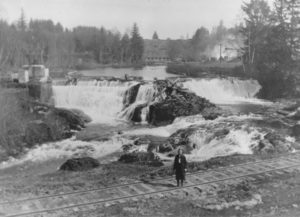
Photo courtesy: Chuck Denney
A 10-foot wide asphalt trail with two-foot-wide gravel shoulders will allow easy access to both parks for walkers, bicyclists and others.
“It will be a nice, level trail,” says Don Trosper, who gives historical tours of Tumwater Falls Park as part of his job with the Olympia-Tumwater Foundation, the not-for-profit private organization that owns and operates the park.
The trail will begin at the current vehicle exit from Tumwater Falls Park where part of the old railroad bed, now covered in grass, can be seen. It will end near the two historical houses that stand above Tumwater Historical Park, which was built in 1980.
“The first plans for a trail were proposed in 1986,” says Chuck Denney, director of Tumwater’s Parks and Recreation Department. “But there was never a big push to connect them.”
Security and safety at Tumwater Falls Park—with its rushing water, two major waterfalls, two bridges and trails running just above the river — resulted in a more significant challenge than at the Historical Park.
But now, working together, the City and the Foundation will bring their plans to fruition.
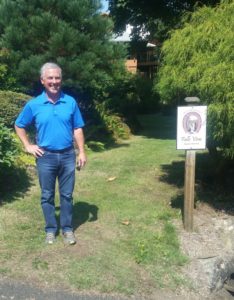
Photo credit: Bob Partlow
“We own all the land on which the trail will be built, but the Foundation has agreed to the idea of the trail,” Denney explains.
Connecting the parks is the initial step of a greater plan for both the City and the Foundation.
The new trail will be the first piece of what will eventually be a 2.7-mile trail connecting five Tumwater parks, starting at Pioneer Park, running by Palermo Pocket Park, Deschutes Valley Park, Tumwater Falls Park and ending at the Historical Park.
It will become a piece of a countywide trail system with other possible tie-ins to land around the Deschutes and Capitol Lake. The Foundation will use the new trail as a linchpin for other changes planned for Falls Park.
The current exit near Falls Terrace Restaurant will be closed. All traffic in and out of the park will come through C Street, which is currently used only as an entrance. “The exit has been troublesome, as motorists and others have to be very careful trying to merge onto Deschutes Parkway,” says Denney.
The park’s native garden will be relocated near its present location below the restaurant. It is planted on the old railroad bed. “Parking near the current exit may be eliminated as the park is reconfigured,” Denney adds.
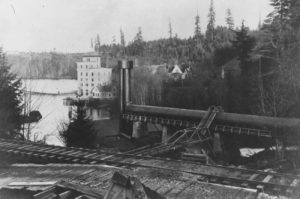
For both the City and the Foundation, the trail represents a chance to preserve and build on the area’s history, of which the railroad was a key, if short-lived, part.
In the 1870s, cities in western Washington were engaged in a fevered competition to be the state’s western terminus for the Northern Pacific Railroad, which eventually chose Tacoma and put a branch line to Tenino – but with no connection to Olympia.
“Without any rail connections, Olympia was faced with commercial annihilation,” wrote Winlock Miller, Jr., in a history reproduced on the website of the Olympia Historical Society and Bigelow House Museum. Local leaders, including Hazard Stevens, son of the territory’s first governor, Isaac Stevens, finally cobbled together enough money to build a railroad from downtown Olympia to Tenino. The railway’s first stop was at the Deschutes River adjacent to what was then the main street of Tumwater.
“On August 1 (1878) the road was formally opened,” Miller wrote. “The entire rolling stock of the road, the locomotive, one passenger car, one box car and three flat cars, carried 350 Olympia people to Tenino, the running time being an hour and a half for fifteen miles.”
“From Olympia to Tumwater the fare was 12c; to Bush Station 50c; to Spurlock 75c; to Tenino $1.00. Ordinary freight was $1.00 a ton, bulky things such as hay $2.00,” Miller continued.
Eventually the Northern Pacific bought the rail line and closed it in 1898.
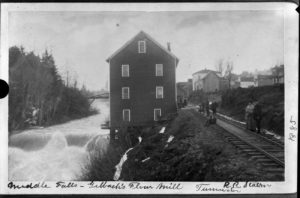
Both parks have tried to respect and interpret the history of the river valley. Cement blocks from the power-generating plant at the lower falls, for example, are used as landscaping near the Falls Park exit and native garden.
People involved with getting the old railroad bed back on track will carry that attitude forward with the new trail.
“A lot of it is about how we are interpreting history,” Denney finishes.
Keep up to date on project details through the Olympia Tumwater Foundation website and Facebook page.













